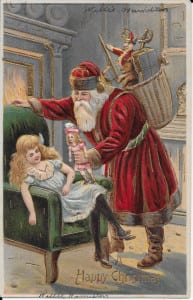By Beverly C. Tyler
The celebration of Christmas, as we know it, goes back about 125 years to the late Victorian era. Following the Civil War, the growth of industry picked up dramatically. By the time of the celebration of the 100th anniversary of the Declaration of Independence in 1876, conditions at home and leisure time experienced by Long Islanders and by the rest of the country changed for the better.

Despite union riots and periods of depression, the decades following the Civil War, known as the Gilded Age, ushered in a time of significant material change. The coming of the railroad in the second half of the century, the improvement in communications that resulted in the beginnings of telephone service in the 1890s, the change in printing methods that brought magazines such as Harper’s and Leslie’s Monthly to many homes and the penny postcard that revolutionized contact between people in America and as far away as Europe all brought new ideas and customs to the local residents.
These, coupled with the masses of immigrants that arrived in New York in the three decades following the Civil War, brought new customs for celebrating Christmas that became a part of “keeping Christmas” for everyone.
The first Christmas card was designed by John Calcott Horsley for Henry Cole of England, later Sir Henry Cole. Cole was the organizer and first director of the Victoria and Albert Museum in London. The card was printed in London by a method called lithography and was hand colored by a professional “colourer” named Mason. It was sent in 1843. It was the custom at the time to send letters to relatives and friends at Christmas. Cole’s cards were to take the place of the letters that he would have to write to his large number of friends and family. A total of about 1,000 of these cards were printed.
By the 1850s and ‘60s Christmas cards were well established in England and were making an appearance in America and throughout Europe. The first American Christmas card was issued by R.H. Pease of New York between 1850 and 1852. The man generally regarded as the father of the American Christmas card, though, is Louis Prang, whose plant was located in Roxbury, a suburb of Boston, in 1856. First in partnership with Joseph Mayer of Boston, but after 1860 as L. Prang & Co., Louis Prang also instituted the idea of competitions for Christmas card designs in 1880, an idea that was instantly copied by his rival in England, Raphael Tuck & Sons. The first prize was 1,000 pounds, and Louis Comfort Tiffany, a Long Islander, was among the judges.
By the 1880s Christmas cards were being printed in the millions and were no longer being hand-colored. Christmas cards during the late 1800s came in all shapes and sizes and were made with silk, satin, brocade and plush, as well as with lace and embroidery surrounding the printed card. These cards were just as varied as those we have today and included religious themes, landscapes from every season, children, animals and the traditional Father Christmas. The cards were very colorful and usually included some verse in addition to the greeting.
Christmas cards were eventually sent through the mail as postcards. The lower price of postage — one cent for a postcard — was one of the reasons for the popularity of the postcard-greeting card. The postcard was most popular during the years between 1895 and 1914, when the craze for collecting cards was at its height. The beginning of the use of postcards probably goes back to the influence of the trade card, used to promote business and trade in the 18th and 19th centuries, and the visiting card, which included the sender’s name prominently added to the card, and was used to send a greeting.
The postcard became popular worldwide and was recognized by the American Post Office Department on May 1, 1873. The card it adopted measured 5 1/8 by 3 inches and was sold by the Post Office Department for one cent each. It was not until 1898 that an act of Congress allowed privately published postcards the same privileges and rates as the government-issued cards.
Many Christmas cards were saved and placed in postcard albums. Today these provide us with a glimpse of life in the late 19th and early 20th centuries.
Beverly Tyler is the Three Village Historical Society historian.






